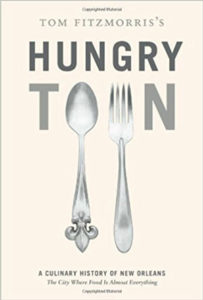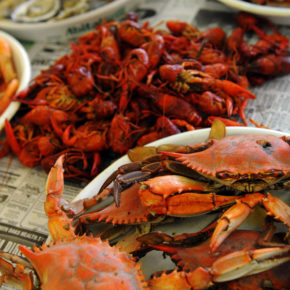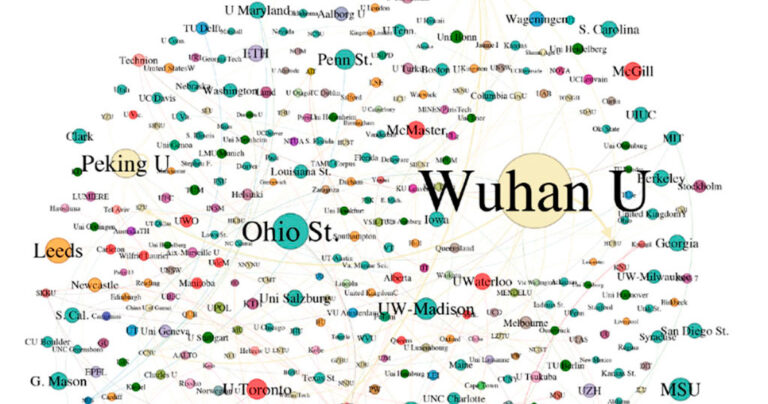Continuing Creolization in New Orleans Foodways
 Among other points of distinction, New Orleans is often and enthusiastically celebrated as a great place to eat. Boosters of the city’s cuisine point to the same cultural hybridity and cosmopolitanism that enabled the flourishing of jazz music and distinctive architectural styles as explanation for the development of Creole cuisine. Tom Fitzmorris, a prominent restaurant critic and radio host in New Orleans since the 1970s and curator of the website nomenu.com, argues in his book Hungry Town: A Culinary History of New Orleans: “Throughout its history, New Orleans was always a net exporter of culinary innovation; we largely ignored what was going on in other cities around the country. With good reason. Outside New York, San Francisco, and Chicago, no other American city was in league with New Orleans in its culture of cookery. And not even those cities had so well-developed and old a native flavor as we did.”[1] The “native flavor” of which Fitzmorris boasts is a near-proprietary blend of European, African, and Native American preparations that highlight local ingredients, especially seafood and certain fresh produce. The most iconic and classic dishes of the New Orleans culinary canon–gumbo, jambalaya, oysters Rockefeller, red beans and rice, turtle soup, anything with shrimp or crawfish–illustrate the creolization of European, African, and Caribbean cuisines while emphasizing the importance of proximity to the Mississippi river, the Gulf of Mexico, and the bayous that characterize the landscape around New Orleans.
Among other points of distinction, New Orleans is often and enthusiastically celebrated as a great place to eat. Boosters of the city’s cuisine point to the same cultural hybridity and cosmopolitanism that enabled the flourishing of jazz music and distinctive architectural styles as explanation for the development of Creole cuisine. Tom Fitzmorris, a prominent restaurant critic and radio host in New Orleans since the 1970s and curator of the website nomenu.com, argues in his book Hungry Town: A Culinary History of New Orleans: “Throughout its history, New Orleans was always a net exporter of culinary innovation; we largely ignored what was going on in other cities around the country. With good reason. Outside New York, San Francisco, and Chicago, no other American city was in league with New Orleans in its culture of cookery. And not even those cities had so well-developed and old a native flavor as we did.”[1] The “native flavor” of which Fitzmorris boasts is a near-proprietary blend of European, African, and Native American preparations that highlight local ingredients, especially seafood and certain fresh produce. The most iconic and classic dishes of the New Orleans culinary canon–gumbo, jambalaya, oysters Rockefeller, red beans and rice, turtle soup, anything with shrimp or crawfish–illustrate the creolization of European, African, and Caribbean cuisines while emphasizing the importance of proximity to the Mississippi river, the Gulf of Mexico, and the bayous that characterize the landscape around New Orleans.
The terms “Creole” and “Cajun” refer to the foodways (and broader cultural characteristics) of urban and rural Southern Louisiana, respectively. Creole describes the population born to settlers in French colonial Louisiana, particularly in New Orleans, as well as native-born people of African descent, both enslaved and free people of color. Like the people, Creole food is a blend of the various cultures of New Orleans (including Spanish, French, African, Italian, German, Caribbean, and Native American, among others), and is typically considered more cosmopolitan and varied than Cajun cuisine. Cajun refers to descendents of the French Canadian settlers forcibly removed from the Acadian region by the British in the mid- 18th century. They settled in the swampy areas of southern Louisiana today known as Acadiana and encompassing four distinct regions: the levees and bayous (Lafourche and Teche), the prairies (Attakapas Native land), swamplands (Atchafalaya Basin), and coastal marshes (New Orleans area and Houma).[2] Cajun cooking continues to draw heavily, in many cases exclusively, from these local landscapes, and has further blended with Creole cuisine to characterize what many believe is “authentic” New Orleans cuisine.

The prominence of indigenous ingredients and dishes in the formulation of a distinctive cuisine is “central to ideas about what is specific about New Orleans” argues University of New Orleans anthropologist David Beriss.[3] Prior to Hurricane Katrina, Beriss explains, New Orleans had a “long-standing food culture, a cuisine, built from local products, that is regularly produced in homes and restaurants and frequently discussed around local tables and in the local media.” This food culture, and the celebratory rhetoric surrounding it, seem to indicate that the city’s creolized foodways are more broadly representative of the cultural and ethnic heterogeneity that have long characterized New Orleans. And while contemporary New Orleans foodways continue to claim distinctive terroir[4] (and merroir – the aquatic equivalent of terroir)–ingredients conveying the taste of their place of origin–the late geographer Clyde Woods reminds us that these foodways and the culture that produced them bear legacies often neglected from the dominant celebratory narratives.[5] At risk of vastly oversimplifying complex historical processes, I want to highlight the importance of colonialism and enslavement for the development of contemporary New Orleans foodways. (I also acknowledge that those processes contributed to the formulation of Southern U.S. foodways more broadly.)
Between 2,000 and 600 B.C., long before European colonization, the Poverty Point settlement in Northeast Louisiana and its surrounding villages had a highly developed pre-agricultural subsistence system based on local plants and game, especially aquatic. Maize-based farming seems to have come late to Louisiana compared the rest of the Mississippi Valley and the Eastern U.S. — only a few hundred years before the arrivals of Europeans. This may have been because of the abundance of wild sources of food, again aquatic as well as terrestrial. As indigenous agriculture declined under the pressure of European settlement, war and exploitation increased. French settlers enslaved women from defeated nations and forced them to both grow food and endure a lifetime of sexual exploitation.[6] As European settlement expanded throughout the region, Woods explains, “many of the new immigrants avoided agricultural labor in the fetid, humid, and dangerous bayous. To solve the plantation and farm labor shortages, the Company of the Indies directed the African slave trade toward New Orleans in 1719.”[7] Most of the enslaved Africans who entered the colony between 1717 and 1731 were transported directly from Senegambia, a West African region whose cooking ingredients (rice, okra, various spices, legumes, and seafoods) and techniques took firm hold in the colonies.[8],[9] New Orleans distinctive cuisine, then, is a product not just of local ecologies, but also of legacies of violence, erasure, and enslavement. Those same legacies contributed to disproportionate exposure to violence and death in the wake of Hurricane Katrina, which devastated the city in 2005.[10],[11]
And yet, in the months and years following the storm, a curious thing happened to the city’s culinary landscape: it experienced what many referred to as a “renaissance.”[12][13] For many, the restaurant industry became a barometer for broader recovery within the city. “If eating out was a major part of social life in New Orleans before Katrina, after the disaster, eating in restaurants turned into one of the central ways the city’s fabric was to be rewoven.”[14] Tom Fitzmorris, mentioned earlier, maintained an index of all open restaurants in the city beginning just a few weeks after the levees broke on August 29; less than two years after the storm, there were more restaurants operating in the city then there were prior to it.[15] Among these were the old standard-bearers of traditional Creole and Cajun cuisine–Galatoires, Antoines, Commander’s Palace, and countless po-boy shops and neighborhood eateries. But the post-Katrina landscape saw an influx of new restaurants catering to new tastes, including those of young, mostly white transplants, but also large numbers of Latinos, whose labor was essential to the rebuilding of the city. These new New Orleanians embraced a wider range of cuisines and eating experiences, leading to a potential fracturing of what constitutes New Orleans foodways. It is nearly as possible to obtain a banh mi as a po-boy in present day New Orleans[16],[17], leading some to fret that “authentic” New Orleans cuisine is under assault. Others celebrate the evolution of a cuisine that embraces tradition while welcoming innovation and expansion–essentially, a further creolization of the “original” Creole cuisine.
While there will always be debates over the meaning (and value) of “authenticity” in foodways, it is certainly the case that foodways and food culture, especially in New Orleans, reflect broader historical and geographic trends and processes. Contemporary New Orleans foodways are a result of forced and voluntary migrations to this ecologically unique region over the course of several centuries. Embedded within the region’s foodways are tensions and contradictions: gourmet excesses abut food insecurity; a mostly white male hegemony reigns in the city’s kitchens (where recent revelations of widespread sexual assault perpetrated by perhaps New Orleans’ most beloved chef have sparked national conversations[18]); African American creative and cultural capital remains subject to appropriation (and reclamation)–these are just a few examples. And yet, food remains a central source of pride for New Orleanians. With all its complexity and contradictions, New Orleans is (still/more than ever?) full of good places to eat.
-Catarina Passidomo, University of Mississippi
DOI: 10.14433/2017.0030
[1] Tom Fitzmorris, Tom Fitzmorris’s Hungry Town: A Culinary History of New Orleans, the City Where Food Is Almost Everything (Abrams, 2014).
[2] Jay D. Ducote, “Cajun vs. Creole Food – What Is the Difference?,” Louisiana Travel, November 25, 2013, https://www.louisianatravel.com/articles/cajun-vs-creole-food-what-difference.
[3] David Beriss, “Authentic Creole: Tourism, Style and Calamity in New Orleans Restaurants,” in The Restaurants Book: Ethnographies of Where We Eat, ed. David Beriss and David E. Sutton (New York: Berg Publishers, 2007), 151–66.
[4] Amy Trubek, The Taste of Place (Berkeley: University of California Press, 2009)
[5] Clyde Woods, Development Drowned and Reborn: The Blues and Bourbon Restorations of Post-Katrina New Orleans, ed. Jordan T. Camp and Laura Pulido, vol. 35, Geographies of Justice and Social Transformation (Athens, GA: University of Georgia Press, 2017).
[6] Woods, p. 7
[7] Woods, p. 9
[8] Judith Ann Carney and Richard Nicholas Rosomoff, In the Shadow of Slavery: Africa’s Botanical Legacy in the Atlantic World (Berkeley, Calif: University of California Press, 2009), https://www.ucpress.edu/book.php?isbn=9780520269965.
[9] Michael W. Twitty, The Cooking Gene: A Journey Through African American Culinary History in the Old South (New York, NY: Harper Collins, 2017).
[10] Michael Eric Dyson, Come Hell or High Water: Hurricane Katrina and the Color of Disaster, 1 edition (New York: Civitas Books, 2007).
[11] Catarina Passidomo, “Whose Right to (farm) the City? Race and Food Justice Activism in Post-Katrina New Orleans,” Agriculture and Human Values 31, no. 3 (September 2014): 385–96, https://doi.org/10.1007/s10460-014-9490-x.
[12] Kim Severson, “The New Orleans Restaurant Bounce, After Katrina,” The New York Times, August 4, 2015, sec. Food, https://www.nytimes.com/2015/08/05/dining/new-orleans-restaurants-post-hurricane-katrina.html.
[13] Brett Anderson, “New Orleans Restaurant Scene Emerging Better after Hurricane Katrina,” The Times-Picayune, August 27, 2010, https://www.nola.com/dining-guide/index.ssf/2010/08/new_orleans_restaurant_scene_h.html.
[14] Beriss, David and David Sutton, “Starter: Restaurants, Ideal Postmodern Institutions,” in The Restaurants Book: Ethnographies of Where We Eat, ed. David Beriss, and David Sutton (Oxford ; New York: Berg Publishers, 2007), 1–13.
[15] Fitzmorris, p. 180-181.
[16] an McNulty, “Orleans Goes Nouvelle,” Gambit, accessed February 23, 2018, https://www.bestofneworleans.com/gambit/orleans-goes-nouvelle/Content?oid=1571316.
[17] “The Lives and Loaves of New Orleans,” Southern Foodways Alliance (blog), accessed February 23, 2018, https://www.southernfoodways.org/the-lives-and-loaves-of-new-orleans/.
[18] Brett Anderson, “John Besh Restaurants Fostered Culture of Sexual Harassment, 25 Women Say,” NOLA.com, accessed February 24, 2018, https://www.nola.com/business/index.ssf/2017/10/john_besh_restaurants_fostered.html.

